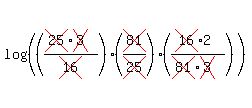Question 593953: Log(75/16)-2log(5/9)+log(32/243)
Answer by jsmallt9(3758)   (Show Source): (Show Source):
You can put this solution on YOUR website! I assume the problem is to combine these logsarithms into a single logarithm. (In the future you should provide the instructions for the problem in addition to the expression.)
There are two ways to combine logarithmic terms:- Logarithmic terms can be added or subtracted but only (like in all parts of Math) if they are like terms. In the case of logarithmic terms they are like terms only if both the bases and the arguments match. So
 can be added. And just like 2x + 5x = 7x, can be added. And just like 2x + 5x = 7x,  . On the other hand . On the other hand  cannot be added because the bases are different, cannot be added because the bases are different,  cannot be added because the arguments are different, and cannot be added because the arguments are different, and  because neither the bases or arguments match. because neither the bases or arguments match. - There are two properties of logarithms which can be used to combine logarithmic terms:These properties require that the bases be the same and that the coefficients are 1's. (The arguments can be the same or different.)
At first glance it might seem that there is no way to combine these terms. We cannot add and subtract them because, even though the bases are all the same, the arguments are different. They are not like terms.
And it would seem that we cannot use the properties either because, even though all the bases are the same, your middle logarithm has a coefficient of 2, not 1. However, there is another property of logarithms,  , which allows us to "move" a coefficient of a logarithm into the argument as its exponent. So we do have a means to combine the logarithmic terms. , which allows us to "move" a coefficient of a logarithm into the argument as its exponent. So we do have a means to combine the logarithmic terms.
We'll start by "moving" the coefficient:


which simplifies to

\
Now that the coefficients are all 1's and the bases are all the same, we can start using the first two properties to combine the terms. Since the first two terms have a "-" between them we will use the second property (which akso has a "-" between the terms):

Using this on the first two terms we get:

Simplifying the first argument:

(For reasons that I hope will be clear soon, I am going to postpone further simplification for now.) Next, because of the "+" between the remaining terms I will use the first property:

to combine them:

Now to finish simplifying. As usual when multiplying fractions it is to your advantage to cancel out common factors before you actually multiply. (The numbers are smaller and easier to factor before you multiply than after.)
See how nicely things cancel:


which leaves:

The multiplication is now about as easy as it can get:


This is the condensed, simplified answer.
|
|
|